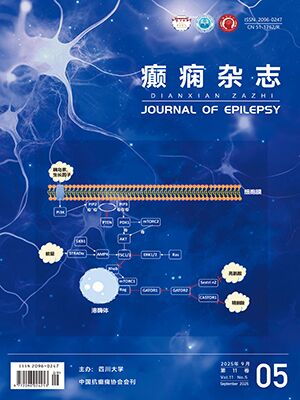| 1. |
王秋菊, 沈亦平, 陈少科, 等. 遗传变异分类标准与指南. 中国科学: 生命科学, 2017, 47(6): 668-688.
|
| 2. |
Sahly AN, Krochmalnek E, St-Onge J, et al. Severe DNM1 encephalopathy with dysmyelination due to recurrent splice site pathogenic variant. Hum Genet, 2020, 139(12): 1575-1578.
|
| 3. |
Li H, Fang F, Xu M, et al. Clinical assessments and EEG analyses of encephalopathies associated with Dynamin-1 mutation. Front Pharmacol, 2019, 4(10): 1454.
|
| 4. |
Kolnikova M, Skopkova M, Ilencikova D, et al. DNM1 encephalopathy - atypical phenotype with hypomyelination due to a novel de novo variant in the DNM1 gene. Seizure, 2018, 56: 31-33.
|
| 5. |
Brereton E, Fassi E, Araujo GC, et al. Mutations in the PH Domain of DNM1 are associated with a nonepileptic phenotype characterized by developmental delay and neurobehavioral abnormalities. Mol Genet Genomic Med, 2018, 6(2): 294-300.
|
| 6. |
Rim JH, Kim SH, Hwang IS, et al. Efficient strategy for the molecular diagnosis of intractable early-onset epilepsy using targeted gene sequencing. BMC Med Genomics, 2018, 11(1): 6.
|
| 7. |
Lazzara A, Asghar S, Zacharia T, et al. DNM1 Mutation in a child associated with progressive bilateral mesial temporal sclerosis. Clin Case Rep, 2018, 6(11): 2037-2039.
|
| 8. |
von Spiczak S, Helbig KL, Shinde DN, et al. DNM1 encephalopathy: A new disease of vesicle fission. Neurology, 2017, 89(4): 385-394.
|
| 9. |
Fung CW, Kwong AK, et al. Gene panel analysis for nonsyndromic cryptogenic neonatal/infantile epileptic encephalopathy. Epilepsia Open, 2017, 2(2): 236-243.
|
| 10. |
Allen NM, Conroy J, Shahwan A, et al. Unexplained early onset epileptic encephalopathy: Exome screening and phenotype expansion. Epilepsia, 2016, 57(1): e12-e17.
|
| 11. |
Nakashima, M, Kouga, T, Lourenco, et al. De novo DNM1 mutations in two cases of epileptic encephalopathy. Epilepsia, 2016, 57(1): e18-23.
|
| 12. |
邓小鹿, 尹飞, 张慈柳, 等. Dynamin-1 基因新生突变导致婴儿痉挛症一例并文献复习. 中华儿科杂志, 2016, 54(11): 856-859.
|
| 13. |
EuroEPINOMICS-RES Consortium; Epilepsy Phenome/Genome Project; Epi4K Consortium. De novo mutations in synaptic transmission genes including DNM1 cause epileptic encephalopathies. Am J Hum Genet, 2014, 95(4): 360-370.
|
| 14. |
McCabe MP, Shore AN, et al. Altered fast synaptic transmission in a mouse model of DNM1-associated developmental epileptic encephalopathy. eNeuro, 17: ENEURO. 0269-20.2020.
|
| 15. |
Dhindsa RS, Bradrick SS, Yao X, et al. Epileptic encephalopathy-causing mutations in DNM1 impair synaptic vesicle endocytosis. Neurol Genet, 2015, 1(1): e4.
|
| 16. |
Lee A, Frank DW, Marks MS, et al. Dominant-negative inhibition of receptor-mediated endocytosis by a dynamin-1 mutant with a defective pleckstrin homology domain. Curr Biol, 1999, 9(5): 261-264.
|




